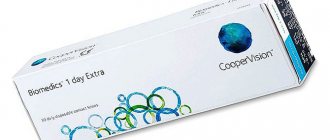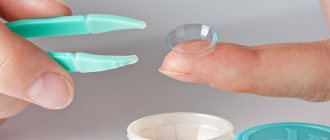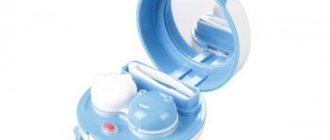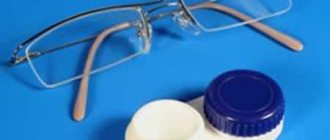Lenses are a convenient alternative to the usual glasses - discreet, functional, modern, and decorative models allow you to create new interesting images and embody original ideas.
The editors of the YaNashla website have prepared detailed instructions for choosing high-quality lenses both for vision correction and for changing appearance.
Advantages
- Does not limit the view;
- They allow you to more effectively correct vision using both transparent lenses with diopters and options that have no analogues among glasses - multifocal, astigmatic lenses. In addition, with their help, it is easier and more comfortable to correct vision when the degree of farsightedness or myopia in the eyes differs by more than 2 diopters;
- Unlike glasses, they do not distort your appearance. So, in glasses for nearsightedness, eyes look smaller, and in models for farsightedness, on the contrary, they look very large;
- Do not fog up when the temperature changes;
- Invisible. No one will tease you for wearing them. People simply don't know about them;
- Indispensable for themed photo shoots and holidays - they help change eye color.
The best colored contact lenses
This option can be produced with or without diopters. The difference here will be that there is its own separate classification, which implies some features when worn. If you have light eyes, then tint options that have a translucent color are suitable. For brown and green eyes, it is best to purchase lenses with a reflective layer.
Air Optix (Alcon) Colors (2 pcs.)
These are the components that saturate the eyes with oxygen. The material used is again silicone using hydrogel, which makes them very comfortable to wear. The pigment is applied using a special technology in three layers, which helps to obtain a natural look. The inside ring gives depth to the look, the middle one serves to obtain the necessary color, and the outer one only emphasizes expressiveness.
Air Optix (Alcon) Colors (2 pcs.)
Advantages:
- Breathable;
- Corrects diseases.
Flaws:
- Can only be worn during the day.
Adria Glamorous (2 pcs.)
These accessories have the widest variety of options and currently include 9 pieces. Visually they enlarge the eyes. Protection against various contaminants is provided, and the lenses breathe oxygen perfectly. Help correct diseases.
Adria Glamorous (2 pcs.)
Advantages:
- Wide color palette;
- Editing dark eye shades;
- Visual enlargement of the eye;
- UV protection.
Flaws:
- Price.
Okvision Fusion (2 pcs.)
This type has the best color brightness and depth of all the models presented. This is ensured by the technology of applying paint in layers. Thanks to this, the natural appearance of the eyes is preserved, and even dark shades are covered. Here you can correct myopia or farsightedness, the level of moisture with the help of increased moisture content. The structure is divided into 2 or 3 tones.
Okvision Fusion (2 pcs.)
Advantages:
- Eye color overlaps;
- Natural appearance;
- Permeated with oxygen;
- No feeling when wearing.
Flaws:
- No.
When should you not wear contact lenses?
Products are contraindicated for any pathologies of the cornea, dysphoria, scars. Lenses are also not suitable for HIV, ptosis, or Graves' disease. It is advisable not to wear them if you have a cold, fever, or elevated body temperature. At this time, the eyes become more watery and easily irritated. In addition, it is undesirable to wear them during an exacerbation of allergies - allergens, for example, pollen or dust, can “stick” to the lens from the air, which will provoke an increased production of tears.
If you take hormonal medications, including COCs, lenses may also not be suitable. The reason is increased dryness of the eyes, which is one of the most common companions to this type of therapy.
You need to remove your lenses immediately if:
- The eyes were very red;
- There was a sensation of a foreign body;
- Your eyes or head hurt.
Then be sure to contact a specialist. This will help identify not only the cause of the current problem, but also prevent the development of any disease in the future.
Lenses for scheduled replacement once a month
For such optics, you will need to purchase a special cleaning solution and container. You may also need tweezers with special silicone pads on the tips. They are replaced once a month.
ACUVUE Oasys with Hydraclear Plus
These contact lenses are among the best in their class. Suitable for people who constantly work with technology and experience stress on the visual system. Water content – 38%. Gas permeability – 147 units.
Advantages:
- lenses “breathe”;
- there are ultraviolet filters;
- there is a moisturizing component that helps reduce the likelihood of dryness and redness of the eyeballs;
- used to correct myopia and farsightedness - range from +8 to -12.
The only disadvantage is that it is uncomfortable to sleep in them.
ALCON Air Optix plus HydraGlyde
This range of lenses eliminates the problem of protein deposits. During their production, the surface is carefully polished with a laser, and it becomes so smooth that contaminants simply do not linger on it.
Advantages:
- gas permeability – 138;
- moisture content – 33%;
- You can wear the optics for up to 6 days without removing them;
- the optical pads are very thin, so they do not create the sensation of a foreign body in the eye;
- blue tint.
The disadvantages include the excessive fragility of the products. The material is so soft and thin that it can easily tear when trying to remove the lens from its storage container.
COOPERVISION Proclear Multifocal
Multifocal lenses for the correction of age-related myopia. Suitable for people over 50 years of age who have difficulty seeing objects both near and far. Increased moisture content (62%) ensures comfortable wearing throughout the day.
Advantages:
- comfortable wearing up to 12 hours;
- the ability to clearly see objects located both close and far;
- do not dry out the mucous membrane of the eye, so there is no need to use additional moisturizing drops;
- durable. The risk of accidentally breaking the lens is extremely small.
They also have a drawback - the lack of a UV filter.
What types of contact lenses are there?
Medical
- Transparent with diopters. They do not change eye color. The main function is optical vision correction;
- Multifocal. Used for age-related farsightedness. Suitable for those people who over time had to buy two pairs of glasses - for distance, constant wear and for near, reading, small work;
- Astigmatic (toric). They are used to correct astigmatism, a disorder of the eye structure when a person sees objects as unclear and distorted. There are practically no analogues among glasses.
Decorative
- Tinted. They enhance or change the natural color of the iris, making the look deeper. Suitable for people with gray or blue eyes, as they are not able to completely cover the color;
- Colored. A more spectacular variation of the previous type. Suitable for people with any eye color, including brown. This usually includes natural shades. They come with diopters and without diopters;
- Carnival. This type includes non-standard variations of colored lenses - red, white, completely black eyes. The most popular and memorable are models with various designs - animal or demonic eyes, images of various objects, patterns.
Air Optix Colors Starling Gray
In terms of popularity among colored contact lenses for brown eyes, Air Optix Colors colored lenses are in first place in the rating list.
Among all the colors of Air Optix Colors, the undisputed leader is Starling Gray – silver gray. It is thanks to the advent of Air Optix Colors Starling Gray lenses that owners of dark, brown eyes have the opportunity to change the color of their eyes to a natural, naturally light color. These lenses look really amazing! Compared to other gray lenses, which have a very visible pattern through which brown color can be seen and at the same time look not at all natural, which immediately catches the eye, Air Optix Color Starling Gray lenses completely cover even the darkest eye color, while their lens pattern is smoothed, absolutely imitating the natural pattern of the iris.
How to choose lenses for your eyes?
To purchase contact lenses, you will need a prescription from a doctor. Please note that a prescription for glasses is completely unsuitable here - lenses are corrected more precisely, so the parameters will differ.
Now let’s look at the main criteria for choosing a product.
Optical power
Otherwise called the “refractive index”. Shows the refractive power of the lens. Indicated in diopters.
Radius of curvature
The individual characteristics for each person depend on the size of the eyeball.
Diameter
The distance between the edges of the product, usually expressed in millimeters. The doctor always indicates this parameter in the prescription.
Replacement frequency
Maximum period of use of the product. Exceeding this time period may cause damage to the eyes. You shouldn’t be fooled by stories on forums and reviews on the Internet that you can safely wear two-week lenses for a month and everything will be fine. This dubious saving can result in expensive treatment.
There are models designed for:
- One day;
- a week;
- Two weeks;
- Month;
- Three months.
The daily ones require no maintenance and are simply thrown away at the end of the day. All the rest must be carefully and correctly processed, and also stored in a special container.
Material
- Hydrogel. They are characterized by low oxygen permeability - they allow little air to pass through, so they are suitable only for daytime wear. This parameter is compensated by the high water content, which eliminates itching and irritation;
- Silicone hydrogel. The newer generation of lenses is breathable and moisture-resistant. There are models that can be worn for a month.
Fresh Look Colorblens Starling Gray, Brilliant Blue and Gemstone Green
In third place in the ranking are Fresh Look Colorblens colored contact lenses. The most popular colors of these lenses for brown eyes are Starling Gray, Brilliant Blue and Gemstone Green. Despite the fact that the colors of these lenses correspond to similar colors of Air Optix Color lenses, they will look slightly different on brown eyes.
Fresh Look Colorblens lenses visually increase the size of the eyes, and their pattern is more noticeable compared to Air Optix Color, which still look more natural.
Errors in selection
- Purchasing a product without consulting a doctor. Purchasing and using the product without a prescription from a specialist may lead to inflammation or eye diseases. Such a product can rub, cause dry eyes, muscle strain or spasms, fatigue, and headaches;
- Purchase without trying on. You can buy lenses both online and offline. An important rule is to try them on before purchasing. For example, you already had lenses from company A and you want to buy a product from company B with similar functionality. Due to the fact that the product is manufactured by different companies from non-identical materials and using different technologies, the selected lenses may not be suitable;
- Trust in unknown companies. You shouldn’t skimp on your health and take the first box you come across. Even well-known companies sometimes produce defective batches, but in this case you will be protected by law. In the case of an obscure shell company, you can only rely on the conscience of the seller;
- Ignoring lifestyle. When purchasing, it is recommended to take into account your rhythm of life, daily routine, and habits. Let's look at a few examples to see which type of product is more suitable. For example, one-day models are ideal for travelers - there is less hassle with them. In addition, you can choose an option with UV protection if you like to conquer mountains or sunbathe for a long time. Products with a high moisture content will be a salvation for the eyes of office workers, since when working at a computer for a long time, a person blinks less, which means the eye becomes less wet.
A little about contact lenses
When choosing contact lenses, on the packaging or in the product card in an online store, you will often find DK/t, moisture content, hydrogel, FDA in the description. What do they mean and how to understand them? Users of optics, especially beginners, do not always know what this means, but these poorly understood designations are an important criterion for choosing lenses. Let's try to figure it out together.
Oxygen permeability coefficient or DK/t.
The bulk of oxygen in the body is carried by hemoglobin and delivered to organs and tissues through the circulatory system. The human eye receives a significant portion of oxygen from the environment, but when wearing lenses it no longer comes into contact with air, but with the lens. The ability of a lens to “carry” oxygen is characterized by the coefficient DK/t. In simple terms, it shows at what speed oxygen molecules pass through the lens to the cornea. This coefficient also takes into account the thickness of the lens. Agree, if the lenses are made of the same material, but one is thinner and the other is thicker, then the speed at which oxygen passes through the lenses will be different. Accordingly, the thinner one has more, and the thicker one, on the contrary, has less. It is important to understand that the oxygen permeability coefficient is directly related to the type of material and moisture content. Thus, silicone hydrogel allows up to four times more oxygen to pass to the cornea and this is not associated with water, while in hydrogel lenses, due to the increase in moisture content in the material, the flow of oxygen through the lens increases. Insufficient oxygen supply to the eye cells leads to blood flow and, as a result, redness of the eyes, as well as discomfort. Pathologies may develop.
Moisture content and type of lens material.
If the lenses contain less than 50% moisture, they are lenses with a low moisture content; if, on the contrary, there is more, then they have a high moisture content. As mentioned above, moisture in lenses is closely related to the material in these same lenses.
Hydrol
or
silicone hydrogel
lenses.
Hydrogel
appeared relatively long ago; the moisture content in these lenses is a very significant criterion, since it is directly related to the coefficient of oxygen transmission to the cornea through the lens. The water in these lenses serves as a “conductor” of oxygen from the external environment to the cornea. The higher the water content in a hydrogel lens, the more oxygen it allows through. Typically, hydrogel lenses have a high moisture content of 48% to 88%.
Pros of hydrogel lenses with high moisture content:
+ Due to their high moisture content, hydrogel lenses allow more oxygen to pass through.
+ High moisture content makes the lenses softer and more comfortable to wear.
There are also disadvantages:
- Lenses with a high moisture content can lose it faster - you will have to use drops and moisturizing solutions.
— A lens that contains more moisture has less strength.
Silicone hydrogel lenses contain less water (from 24% to 60%) and, due to the silicone component, have greater oxygen permeability. This is due to the fact that water no longer plays the role of the main “conductor” of oxygen. Silicone does not interfere with the flow of oxygen from the external environment and serves as a “reinforced” frame with many holes through which oxygen enters the cornea. Usually these lenses are referred to as “breathable” and these are not just words. Some models made of silicone hydrogel, according to manufacturers, can be left in place for up to 30 days and this will not lead to eye health problems. The lens does not interfere with the normal gas exchange of the cornea with the external environment.
Pros of silicone hydrogel lenses:
+ High coefficient of oxygen permeability.
+ The lens is stronger due to the use of silicone, it is more difficult to tear.
+ Low moisture content ensures moisture retention inside the lens, it stays moisturized longer.
Minuses:
— Silicone is a denser material than hydrogel - discomfort may occur, especially if selected incorrectly.
— Silicone does not interact with water - the lens is less wet.
Classification of material by FDA groups.
In North America, lenses are classified according to the material's ionicity and moisture content. The classification was prepared and implemented by the US Commission for Food, Drug and Cosmetic Control - Food and Drug Administration, abbreviated as FDA
The first group is non-ionic materials with a moisture content of less than 50%
The second group is non-ionic materials with a moisture content of more than 50%
The third group is ionic materials with a moisture content of less than 50%
The fourth group is ionic materials with a moisture content of more than 50%
Non-ionic materials do not have an electrical charge and, as a result, do not attract proteins, fats and other contaminants. We can say that they become less polluted and it is easier to part with pollutants. At the same time, ionic materials are more prone to deposit accumulation.
In the “dry” residue.
The main thing is that lenses are selected not only based on material parameters, moisture content and other things, lenses are selected by size. It is very important that a qualified specialist select exactly your lens size and evaluate its fit on the eye. Knowing your sizes and needs, you can choose lenses from a fairly wide range. Surely, you have a question, which material is better? In our opinion, more modern lenses based on silicone hydrogel materials have more advantages, but there is no definite answer, it all depends on your individual characteristics and what mode of wearing lenses you choose.
Rating of quality eye lenses for 2020
We offer you an overview of comfortable, safe and popular lens models. The list is divided into two groups - medical lenses for vision correction and decorative lenses for changing appearance. The description of each model contains the characteristics of the product, its pros and cons.
Medical with diopters
Air Optix (Alcon) Aqua (6 lenses)
Flexible wear lenses are made of highly breathable silicone hydrogel and provide comfortable, itching- and irritation-free wear all day long.
Average price: 1365 rub.
Air Optix (Alcon) Aqua lenses
Advantages:
- Comfortable to wear;
- No rubbing, no feeling of “sand in the eyes”;
- There are options with optical power from +6 to -9.5;
- Breathable - oxygen permeability 138 Dk/t;
- Moisture content—33%;
- According to user reviews, they are of high quality - they rarely break, fail, and have a low percentage of defects.
Flaws:
- High price;
- There are only options with a radius of curvature of 8.6.
Dailies (Alcon) Total1 (30 lenses)
A set of one-day silicone hydrogel lenses with a gradient moisture distribution - the moisturizing composition is located on both sides of the lens and is distributed unevenly. This allows you to maintain the desired level of humidity throughout the day.
Average price: 1447 rub.
Lenses Dailies (Alcon) Total1
Advantages:
- Thin, not felt on the cornea;
- Best option for sensitive eyes;
- Indispensable for travelers, as well as simply active people;
- There are options with optical power from +6 to -9.5;
- High oxygen permeability – 156 Dk/t;
- Moisture content of 80% - a product of increased comfort, the eyes do not dry out or itch;
- There are 30 pieces in a box.
Flaws:
- Price;
- Available only with a radius of curvature of 8.5;
- They tear quickly and are very tender.
Acuvue OASYS with Hydraclear Plus (6 lenses)
Two-week silicone hydrogel lenses are suitable for office workers who spend the whole day at the computer.
Average price: 1001 rub.
Acuvue OASYS lenses with Hydraclear Plus
Advantages:
- The eyes do not get tired;
- Two radii of curvature are available - 8.4 and 8.8;
- There are options with optical power from +8 to -9.5;
- Good oxygen permeability (147 Dk/t) ensures comfort and safety of the cornea;
- Moisture content—38%.
Flaws:
- Price.
Air Optix (Alcon) Aqua Multifocal (3 lenses)
A set of multifocal silicone hydrogel lenses designed for one month of wear. Needed to correct age-related farsightedness. According to the manufacturer, the product can be left in place for up to 6 days.
Average price: 879 rub.
Air Optix (Alcon) Aqua Multifocal lenses
Advantages:
- Price;
- You can purchase copies with optical power from +6 to -9.75;
- Good oxygen permeability - 138 Dk/t.
Flaws:
- Poor moisture content—33%, eyes may become dry;
- There is only one radius of curvature available - 8.6.
Acuvue OASYS 1-Day with HydraLuxe for Astigmatism (30 lenses)
Astigmatic silicone hydrogel daily lenses.
Average price: 1090 rub.
Acuvue OASYS 1-Day lenses with HydraLuxe for Astigmatism
Advantages:
- Thin;
- Comfortable, weightless, easy to wear;
- A good find for those who lead an active lifestyle;
- Two radii of curvature are available - 8.5 and 8.6;
- There are options with optical power from +4 to -9;
- Oxygen permeability 121 Dk/t - the eye under the lens is provided with oxygen;
- There are 30 pieces in a box;
- Moisture content—38%.
Flaws:
- Price.
Decorative
Air Optix (Alcon) Colors (2 lenses)
Silicone hydrogel colored lenses for monthly replacement, allowing you to both change your eye color and combine business with pleasure - correct your vision and add something new to your image.
Average price: 721 rub.
Air Optix (Alcon) Colors lenses
Advantages:
- Price;
- Available in five colors - blue, green, gray, blue, brown;
- Soft, thin;
- Look natural;
- Covers brown eye color;
- You can purchase copies with optical power from 0 to -8;
- Sufficient level of oxygen permeability - 138 Dk/t;
- The eyes don't dry out.
Flaws:
- Low water content - 33%;
- Only one radius of curvature - 8.6.
ADRIA Glamorous (2 lenses)
Daytime hydrogel colored lenses are designed for three months of wear. They will allow you to try on different images, while simultaneously improving your vision.
Average price: 790 rub.
ADRIA Glamorous lenses
Advantages:
- Price;
- Wide selection of colors - green, golden, brown, purple, blue, black;
- Soft, comfortable;
- Look natural;
- You can purchase copies with optical power from 0 to -9.5;
- A sufficient level of oxygen permeability is 22 Dk/t.
Flaws:
- Do not cover brown eye color;
- Low water content - 43%;
- There is only one radius of curvature available - 8.6;
- The eyes dry out, so they are not suitable for long-term wear;
- According to customer reviews, the side view may take on the color of the lens.
ADRIA Crazy (1 lens)
Hydrogel carnival lenses with unusual patterns will be the final touch to your party or holiday outfit. Your look will become more attractive and mystical, and your photos will become more original.
Wearing period is 3 months.
Average price: 490 rub.
ADRIA Crazy lenses
Advantages:
- Affordable;
- Several dozen drawings with interesting colors - cat's eye, demon, wolf, radiation icon, cobweb;
- Covers any eye color.
Flaws:
- They do not correct vision, they only decorate;
- Low water content - 38%;
- Low level of oxygen permeability - 19 Dk/t;
- The radius of curvature is 8.6.
The best contact lenses for a month
This type is slightly inferior to the previous one, although the long service life is much better, but timely maintenance is required. Here you need to know several parameters: meeting deadlines and fulfilling all cleansing instructions. Any element must be thoroughly cleaned, because they have the ability to collect harmful particles. If you wear a lens that lasts for a month more, you will subsequently experience irritation and redness.
Coopervision Biofinity (6 pcs.)
Contact lenses of this brand can be used both during the day during work and with flexible wearing mode. This allows you to wear them at any time of the day for their intended purpose. They are also made of silicone, which is one of the best materials today. This is where myopia and farsightedness are corrected. Comfort is ensured for up to 7 days of wearing in a row, and there is also humidification and oxygen enrichment.
Coopervision Biofinity (6 pcs.)
Advantages:
- Absolutely any wearing mode;
- The material is naturally moisturized;
- No need to use drops;
- Well saturated with oxygen.
Flaws:
- Quite a high price.
Maxima 55 UV (6 pcs.)
Budget models for sensitive eyes start with this lens option. The average price is 700 rubles, which introduces something new to popular models. There are many advantages, which include correction of various diseases, good visibility, ease of wearing, and protection from ultraviolet radiation. And thanks to processing using new technology, they are made in a more invisible version, which allows them to be saturated with oxygen. The surface is completely matte. They are equipped with a slight coloring so that they are visible when stored in solution.
Maxima 55 UV (6 pcs.)
Advantages:
- Good functionality;
- Subtlety of detail;
- Ease of use;
- Good price.
Flaws:
- Needs to be looked after;
- Purchase additional storage solution.
Air Optix (Alcon) Aqva (6 pcs.)
The next representative showed an option with a shelf life of a month for long-term wear. And they are also made of silicone, which is characterized by good hydrophilicity and oxygen saturation. This drug is perfect for those patients whose eyes are too sensitive. The surface is treated with a preparation that increases wearing comfort. Thanks to the processing of lenses, protection against various types of deposits, as well as against the ingress of cosmetics or dust, increases.
Air Optix (Alcon) Aqva (6 pcs.)
Advantages:
- Good oxygen saturation;
- Can be worn constantly.
Flaws:
- May cause discomfort during sleep.
Menisoft (3 pcs.)
These are monthly replacement hydrogel contact lenses developed by the famous Japanese company Menicon. Exceptional moisture content - 72% - and optimal oxygen permeability ensure wearing comfort. The lenses are manufactured using a turning method, which achieves precision processing of the optical surface - and, as a result, high visual acuity. In addition, impeccable image quality and ideal fit are due to the bi-spherical design of the outer and inner sides of the lens.
Menisoft contact lenses (3 pcs.)
Advantages:
- Legendary quality of Japanese optics;
- Optimal oxygen permeability;
- Highest moisture content;
- Suitable for people with dry eye syndrome;
- Affordable price.
Flaws:
- One universal base curvature.
Miru 1month Menicon
Silicone hydrogel monthly contact lenses that “breathe”, supplying the cornea with an optimal amount of oxygen throughout the day. When choosing between different brands of lenses, it is important to give preference to those that are safe for eye health. Japanese Miru 1month lenses with oxygen permeability of 161 Dk/t provide high visual acuity and wearing comfort. They are created from an advanced material using a special Nanogloss™ surface treatment technology to increase the smoothness and wettability of the lenses.
contact lenses Miru 1month Menicon
Advantages:
- Exceptional oxygen permeability – 161 Dk/t;
- Optimal moisture content;
- Two base curvature options – 8.3 mm/8.6 mm;
- High quality Japanese optics;
- Indicator of the inside of the lens.
Flaws:
- The price of premium lenses is higher than the market average.
Important! Despite the fact that manufacturers of monthly lenses indicate the possibility of continuous wear for 7 days or more, ophthalmologists recommend, if possible, removing the accessory at night.
Accessories: what might you need?
The mandatory list of lens care products includes:
- Storage container;
- Disinfectant solution;
- Moisturizing drops.
The container is purchased for a couple of months. In it, lenses filled with disinfectant solution are stored as long as you do not wear them. Sometimes it is convenient to buy two containers - the main one and the travel one. The first one will be at home, and the second one will be useful in cases where you need to remove lenses outside the home - in the pool or due to poor health.
In addition to its disinfecting function, the solution cleans, moisturizes and helps keep the lens in proper condition. Liquids with hyaluronic acid are considered optimal in composition. Such solutions are very similar in composition to human tears.
Moisturizing drops are necessary for owners of any lenses. With their help, it is easier to put on the product and also more comfortable to wear. For example, if you spend a lot of time at the computer or in a room where the air is dry due to heating, then such drops will relieve you of unpleasant sensations.
An otolaryngologist will help you choose the best and high-quality accessories for your lenses.
How to properly put on and remove lenses?
To quickly remove and put on lenses you need a little practice.
Find some free time on the weekend or after work in the evening. Be calm, don't worry. Remember that even if you fail, you can try again in a few minutes or later.
It is better to conduct your first training on a clean, flat surface in a well-lit room.
Before handling your lenses in any way, wash your hands thoroughly and then dry them with a lint-free towel or paper towel.
How to wear?
- Take the lens with your right hand. Place it on the pad of your index finger;
- Make sure it is not inside out. A straight lens is part of a ball, while an inverted lens has curved edges. By the way, many manufacturers supply their products with indicators of the correct position - these can be simply numbers or letters, or a weight sign (for astigmatic lenses);
- Keep your eyes open. With your left hand, pull down your upper eyelid a little - this will help you avoid blinking. Holding the lens on your finger, pull the lower eyelid with your free fingers;
- Using a firm, precise motion, place the lens into the eye. Look up while doing this. Then release the eyelid and blink a couple of times - this will allow the lens to take the correct position;
- Repeat on the other eye.
Don't worry, the product can't roll or float behind the eye.
If you are a little worried, then look at the photos or videos of the process and you will succeed.
How to remove?
- Look up or to the side and up, and then lower the lower part of the eyelid with your middle finger;
- Place your index finger towards your eye. Do this slowly, otherwise the eye will close. Touch the lens, then move it down towards the white part of the eye;
- Using your thumb and forefinger, squeeze the product slightly, then remove it;
- Repeat with the second copy.
If the lens does not come off, apply a few drops. If you have reusable lenses, be sure to treat them immediately.
Features and benefits of soft contact lenses
According to statistics, about 90% of people who use lenses prefer soft models. They have several undeniable advantages:
- they are elastic and thin;
- fit tightly to the cornea;
- suitable for correcting farsightedness, myopia and astigmatism;
- do not require adaptation, so they are suitable for those who occasionally replace glasses with lenses;
- allow oxygen to pass through;
- the material retains a lot of moisture, therefore preventing dry eyes;
- provide clarity of central and peripheral vision;
- suitable for people with increased sensitivity, as they do not cause discomfort while wearing.
Proper care
Cleaning scheduled replacement lenses
- Pour fresh disinfectant solution into the container;
- Clean the first lens. To do this, place it on your palm, apply a few drops of disinfectant solution and wipe it with your finger;
- Rinse the product by applying a few more drops of liquid;
- Turn the product over and repeat the procedure;
- Place the treated lens in a clean container.
Cleaning the Container
- Pour the used solution out of the container;
- Rinse the container with fresh lens solution;
- Dry the container. To do this, turn it upside down and place it on a paper or any other lint-free napkin.
Once every 1-2 months, do not forget to replace the container with a new one.
It is strictly forbidden to clean the lenses or container with water - tap or bottled.
Various impurities and microorganisms, such as chlorine, iron or lime, will not only easily damage fragile products, but can also cause injury or eye infection.
Difference between 2 types of contact lenses
The main difference is the price of the product. Alcon DAILIES Total1 5 pk lenses are 2 times more expensive. Total1 soft optics are recommended by ophthalmologists for myopia and hyperopia, as well as for people who require additional correction within +3.00 diopters while reading.
This type is suitable for the correction of astigmatism (up to +1.5 D), as well as for patients with increased eye sensitivity. AquaComfort PLUS are also intended for the correction of myopia and farsightedness. The radius of curvature of this type is 8.7 (versus 8.5 Total1). Optical correction of astigmatism is performed in the case of a minimal degree of refractive error of the eye. Find out also about Bausch Lomb lenses in the article.
Tips for beginners
If you're just starting to wear contacts, add a reminder to your phone to take them out at the end of the day. Over time, you will develop a healthy habit.
You can also add a notification to your calendar to let you know when you need to buy a new pack of lenses. This will save you from unnecessary worries and surprises.
Also on the websites of some manufacturers you can download branded applications, with which you can not only systematize your habits, but also get a discount, directly consult with a specialist or make an appointment.











